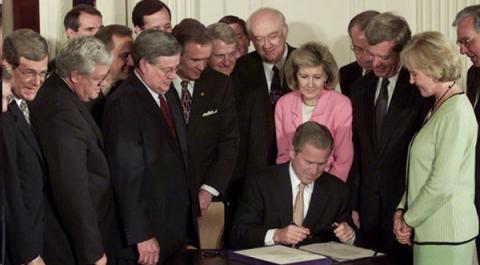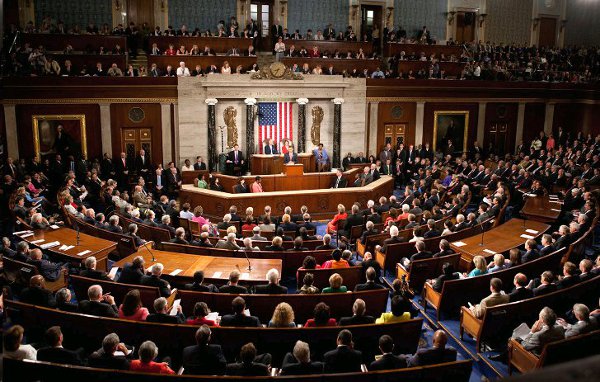The Bush Tax Cuts: Bad Yesterday, Bad Today, and Bad Tomorrow

Throughout his two presidential election campaigns and during his eight years in the White House, George W. Bush was nothing if not consistent about his top domestic policy priority. As an early favorite for the Republican presidential nomination in 1999, Bush promised to cut taxes for all Americans. When Bush accepted the Republican nomination in 2000, he continued to call for lower taxes.
In an October debate with Al Gore, Bush proposed using much of the projected government surplus to fund tax cuts. Accepting Gore’s concession of the hotly contested election, Bush called on Washington to “seize this moment and deliver” on his priorities, including tax cuts. Bush kept up the drumbeat in his inaugural address, once again promising to slash taxes. In his first address before a joint session of Congress that February, Bush kept to this theme and outlined his proposed tax structure. Bush got his wish in the summer of 2001, when Congress passed a sweeping set of tax changes known as Economic Growth and Tax Relief Reconciliation Act (EGTRRA).
EGTRRA created six tax brackets, helping low-income taxpayers by placing them in a new 10 percent tax bracket. If the tax cuts expire as scheduled at the end of 2012, the lowest-earning bracket would once again become the 15 percent rate, a potentially painful increase for workers making less than roughly $35,000 a year. The country’s highest earners, those making more than $379,650 a year, would see their rates return to 39.6 percent, the same rate they paid during Bill Clinton’s presidency.
Perhaps just as significant, EGTRRA doubled the child tax credit from $500 to $1,000. EGTRRA also loosened standards for the credit, meaning families that previously benefitted from it would be left out if the cuts expire. Additionally, tax rates on qualified dividends and long-term capital gains stand to rise from the current rate of as low as zero percent back up to as high as 20 percent, with qualified dividends again taxed at the regular rate for the filer.
President Bush was hardly satisfied when Congress passed EGTRRA. Even after the horror of September 11, 2001, President Bush remained committed to cutting taxes. While the 2001 cuts were sold as a means of returning the budget surplus to taxpayers, by 2003 the White House needed a new justification to continue to slash tax rates. With the economy showing signs of stumbling, Republicans sold the 2003 round of tax cuts by saying "we need tax relief totaling at least $550 billion to make sure our economy grows, and American workers and American businesses need every bit of that relief now so that people who want to find a job can find one."
Congress acquiesced and passed another round of changes to the tax code, this time focused on capital gains and dividends. Known as the Jobs and Growth Tax Relief and Reconciliation Act of 2003, this law combined with EGTRRA to significantly change how the federal government would collect revenue for the next 10 years.
Both tax packages are set to expire at the end of 2012. Proponents of the Bush tax rates claim these changes could hamper saving and spending at a delicate economic time. The prospect of these tax rates holding lawmakers hostage is especially painful considering their minimal impact when they were first passed.
Cliffhanger
For all the rancor and bickering in Washington, both parties can agree that the U.S. is headed for major financial trouble at the end of 2012. To conservatives, the cause of this potential catastrophe is the U.S. national debt, which has become “literally an ‘existential threat’” to America’s finances. Thinkers from the American Enterprise Institute have predicted that the debt could “have catastrophic consequences for the future of the nation.” Much more than just a policy issue, thinkers from institutions such as the Heritage Foundation warn the national debt will turn America into “a kingdom of subjects.” The immediate cause of this potential catastrophe, however, is the tax cuts a Republican president relentlessly championed.
Due to a complex set of mechanisms worked into the 2001 and 2003 Bush tax packages, coupled with spending cuts scheduled during the 2011 debt ceiling debate, America could be ringing in 2013 with a “fiscal cliff” set to kick in on January 1. If Congress fails to act by then, spending cuts coupled with tax increases threaten to throw America back into recession, potentially adding trillions to the debt over the next 10 years.
Investor confidence has suffered from the prospect of this train wreck, with a recent survey finding a significant rise in pessimism. Only 41 percent of investors from a recent Wells-Fargo survey believe it is currently a good time to invest, compared to 48 percent in May and 52 percent in February. This situation is not only impacting American investors. The International Monetary Fund (IMF) has warned that the fiscal cliff has the potential to push the already frustratingly sluggish economic growth rate under 1 percent, with negative ramifications for the globe.

At the end of 2012, Congress can take a major step toward solving this impending crisis and protecting the middle class at little cost to American’s long-term budget situation. Strategically allowing some of the tax policies implemented during George W. Bush’s terms to expire at the end of 2012, thanks to “sunset provisions” worked into the law, would go a long way to solving America’s short-term budget problem, and put it on much stronger future to weather impending budget crunches.
The economy expanded after 2001, with Republicans quick to credit the tax cuts. However, economic studies have shown the 2001-2007 economic expansion was weak compared to other expansions in the post-World War II era. Analysts from HIS Global Insights found that the housing boom partially masked weak job growth from 2002 to 2006, creating from 600,000 to 800,000 jobs the economy would not have generated otherwise. Mark Zandi, Chief Economist at Moody’s Economy.com and an unofficial adviser to John McCain, has called the era of the housing and finance boom “almost a lost economic decade.”
For the Byrds
America’s long-term budget problems are largely due to forces beyond U.S. lawmakers’ immediate control, such as an aging population, the European debt crisis, and the 2008 economic collapse. The expiration of the tax cuts, however, is due to a specific budget provision known as the Byrd Rule. A minority party may use a parliamentary procedure known as reconciliation to circumvent a filibuster in the U.S. Senate. Ten years before the Democrats used the maneuver to overhaul health care, Republicans used reconciliation to give Bush his 2001 round of tax cuts without the 60 Senate votes needed to invoke cloture and avoid a filibuster. Because of the Byrd rule, however, the Republicans could not pass the tax cuts, which would have added significantly to the deficit, without covering their long-term costs with an expiration provision.
According to Paul O’Neill, the Treasury secretary under Bush who helped sell the tax cuts, the sunset provisions were “baloney.” He claims Republicans had no intention of actually allowing the cuts to expire after 10 years: “It was put in there so they could make a fiscal claim that it wouldn’t damage us. It had nothing to do with reality.”
Zandi has calculated that making all of the Bush tax cuts permanent would create 35 cents of economic growth for every dollar in lost revenue. Investing in a national infrastructure program, on the other hand, has the potential to provide relief for unemployed workers and provide a boost to the businesses that would feed, house and clothe them. Additionally, the federal government could use the added revenue gained from placing slightly higher rates on America’s biggest earners to provide grants to cash-strapped states to rehire laid-off teachers, social workers, firefighters and other civic employees. With the federal government’s borrowing rates still very low, these and a number of other options would provide much more cost-effective stimulus than continuing the tax cuts.
Still Crazy After All These Years
While it’s difficult to calculate the overall impact of the Bush tax cuts, the Great Recession might actually have made them less detrimental to America’s finances. Because the economic slowdown drastically reduced government revenues, gross domestic product was well below projections, and the loss of revenue was actually somewhat lower than the Congressional Budget Office initially projected. Nevertheless, the Bush tax cuts left America in a much weaker position to cope with the 2008 crash, and thanks to its sunset provisions, left Congress with the additional burden of either raising taxes and potentially choking off a fledging recovery, or extending the cuts for all taxpayers yet again.
The best option for dealing with the Bush tax cuts is probably to extend the cuts for those making under $250,000 a year. Congress could set an automatic point for tax rates to go up on those making less than that threshold, for example, when the unemployment rate dips below a certain percentage point. Congress could also delay the automatic spending cuts until the economy returns to a stronger footing. Lawmakers are already considering such a move, according to congressional insiders.
However Congress chooses to deal with the ramifications of the Bush tax policy, it will be a painful hangover from a policy obsession that left the U.S. with a less secure future in exchange for weak and unevenly distributed growth. The Bush tax cuts are not only attributed to the debt and economic problems hampering America’s recovery from the Great Recession, but they have put the country in a weaker position to make the kinds of investments needed to bring the unemployment rate down and restore sustainable economic growth.
Author Bio:
Matthew Rudow is a contributing writer at Highbrow Magazine.




























































































































































































































































































































